Purchasing a filling machine can be complicated. With so many options available, it's difficult to know which one is right for your business. Here are 7 questions to ask before buying a bottle filler to help guide you to selecting the best piece of equipment for your production needs:
1. So, You're Purchasing a Filling Machine....What Exactly Will You Be Filling?
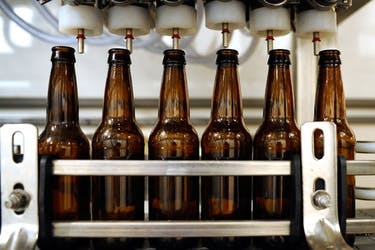
While some bottle fillers are designed to fill containers with dry goods such as powders or pills, others are best suited to handle liquids. Therefore, if you're looking into purchasing a filling machine, once of the most important factors to consider is your product's viscosity, or consistency. The viscosity of your product will help you to determine what type of filling technique the machine must use in order to properly handle your item's particular attributes.
If your product has a high viscosity, like molasses, you'lll want to consider purchasing a filling machine that can handle that item's physical properties. Think about it - it's a far different task for a liquid filler to pump a product with a low viscosity (i.e. water) into a bottle than it would be for that same filler to pump a high viscous liquid such as molasses into the same bottle - right? To learn more about the most accurate way to measure your product's viscosity.
2. Is Your Product Carbonated?
Carbonated beverages (i.e. beer, soda, champagne) require a unique type of filling technique, as well as specialized filling equipment. As a result, you'll need to consider purchasing a filling machine that's designed to properly fill/bottle your carbonated product. These machines are called a counter pressure fillers.
A counter pressure filler preserves the carbonation of the liquid, even as it's bottling, through a process called double pre-evacuation. This method works by removing air from the bottle and pressurizing it with carbon dioxide. Finally, by repeating the process to remove 99.99% of the oxygen (double pre-evacuation), the final result is a bottled carbonated product with a much longer shelf-life, thanks to these repeated pre-evaution cyclces.
3. What Type of Container Are You Filling?
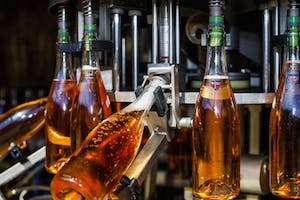
Another key factor in purchasing a filling machine is knowing as much as possible about the physical properties of the containers you'll be using. Determining what type of container you'll be filling is a key question to ask before buying a bottle filler, as this will help dictate what type of filling technique the machine must use. This is due to the fact that the bottle's attributes must be compatible with the machine's filling method in order for the filler to function properly.
For example, some automatic bottle fillers grab the container from the top, while others grab from the side. Therefore, if your bottle has a unique cap or lid, a filling machine that grabs from the top might not work for that particular kind of container. Similarly, if your bottle is too wide, a filler that takes hold of the container from the side probably isn't the best choice for your individual production needs.
Finally, an additional key aspect to consider regarding the container you'll be using is whether it's made of glass or plastic. Furthermore, would you prefer a filling machine that's designed to fill an aluminum can rather than a bottle? All three kinds of materials require fillers that use their own particular type of filling technique, which must be compatible with the container you're going to be using. If you're on the fence about which kind is best suited for your product, head over to the Kinnek Q&A on bottling versus canning and join the discussion!
Knowing the physical properties of the container you'll be filling is absolutely essential when purchasing a filling machine since the bottle's attributes will ultimately be a key factor in determining the best type of filler for your production needs. Furthermore, it's also important to share this information with the suppliers you're thinking of buying from, since the container's attributes will ultimately determine whether or not the supplier has the filling machine that's best for your individual operation.
4. What is Your Production Rate?
When considering the efficiency of a filling machine, it's important to keep both your current and future production needs in mind, since upgrading your machinery might not be feasible if/when you decide to expand your business. Smaller machines are usually measured by the amount of bottles they produce per hour (BPH), while faster, larger, fillers are typically calculated based on bottles per minute (BPM).
For example, a manual bottle filler is a great entry-level investment for a start-up or a very small company, but will most likely not be able to meet the demands of a small-to-medium-sized operation or even a small business that's planning to expand/increase production.
5. Which Type of Filler Automation System Is Best - Manual, Semi-Automatic, or Automatic?
When purchasing a filling machine, determining which type of filler is best suited for your individual production needs is definitely key.
Manual filling machines are a great option for home brewers, entry-level brewing enthusiasts, or small-scale companies with only a few employees and no plans for growth. That being said, manual bottle fillers are designed to handle fairly low production rates and for that reason, aren't a great choice for any small-to-medium-sized operation or a small business with plans for expansion.
Semi-automatic filling machines are a great "in-between" option for most small businesses, and pretty ideal for any start-up or small company that's planning to grow their operations. These machines are capable of producing more than a manual bottle filler, but still require a bit of manual operating, which can obviously slow down your entire process. Pricewise, they're about mid-range between the costs of a manual filler and a fully automated machine. Considering all of that, semi-automatic fillers can definitely be an affordable, smart investment for any small business looking to move up from manual filling but not quite ready to graduate from an entry-level filling machine just yet.
Last but certainly not least, automatic filling machines are the best choice for any advanced and/or large-scale operation with higher production rates. While these machines do take up more space than both the manual and semi-automatic fillers, they require little-to-no manual handling since the bottles are pulled from the bulk using a coveyor system. Automatic filling machines are generally more expensive - both to purchase and maintain - however, if you're a medium-to-large sized operation with greater productivity requirements, then an automatic filler is definitely worth the investment and the surefire way to go.
6. Liquid-Level or Volumetric - Which Type of Filling System Should Your Machine Use?
When you're thinking about purchasing a filling machine, one of the most important factors to consider is which type of liquid filling system is best for your operations - a liquid-level filler, or a volumetric filling machine. Ultimately, the type of filler you choose should be based on two key pieces of information: the of product you're going to be using to fill your containers, and how you want the final fill-level in your bottles to appear.
Regardless, it's important to keep in mind that all filling systems fall into one of these two categories - liquid-level or volumetric - so if you're having trouble deciding which one is better for your operation, head over to this Kinnek Q&A to learn more and join the discussion!
Within these two categories of filling systems are several different "sub-types" of liquid fillers, as well: overflow pressure fillers, which are amoung the most popular tytpes of liquid-level filling machines, and gravity-fed, piston and pump fillers, which all use volumetric filling principles.
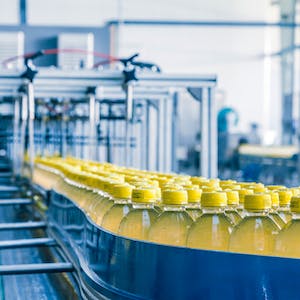
Liquid-level filling machines are designed to fill each container to the same, specified level, regardless of the volume of the product that's inside the bottle. This option is ideal for most liquids since the filling process is cheaper and more efficient than with volumetric fillers. More importantly, for companies that prefer a more uniform, cosmetic-looking fill, liquid-level fillers produce a final fill-level that is visually more appealing to consumers. This is due to the fact that each of the filled containers "appear" to have the same volume of liquid when in actuality, may vary from bottle to bottle.
Finally, liquid-level fillers can also help your business achieve higher speeds of production and, in many cases, a lower cost per machine, potentially saving your company up to tens of thousands of dollars.
Liquid-level filling machines are designed to fill each container to the same, specified level, regardless of the volume of the product that's inside the bottle. This option is ideal for most liquids since the filling process is cheaper and more efficient than with volumetric fillers. More importantly, for companies that prefer a more uniform, cosmetic-looking fill, liquid-level fillers produce a final fill-level that is visually more appealing to consumers. This is due to the fact that each of the filled containers "appear" to have the same volume of liquid when in actuality, may vary from bottle to bottle.
Finally, liquid-level fillers can also help your business achieve higher speeds of production and, in many cases, a lower cost per machine, potentially saving your company up to tens of thousands of dollars.
Overflow-pressure fillers are one of the most popular and sought-after types of liquid-level filling machines on the market. This is due to their ability to fill large quantities of bottles at an extremely fast fill-rate. These machines are built for speed, pumping liquid directly into the bottle and achieving a consistant, uniform fill-level in every single container. Once the bottle is filled to the desired level, any excess product left in the filling tubes is pushed back to the tank, preventing overflow and spillage - yet another positive aspect of overflow-pressure fillers. These types of filling machines are also extremely versatile, capable of bottling a wide range of liquids with many different viscosities, which allows them to be used in a variety of industries, as well.
Alternatively, volumetric filling machines are designed to fill bottles with an "exact" volume of liquid despite the varying appearence it produces of the final fill-levels in each container. This is due to the fact that most bottles have minor variations in volume to begin with, which causes the fill-levels to appear differently in the containers - particularly ones made of glass or clear-plastic.
Volumetric fillers also require special instruments for balance, calibration and timing, resulting in an overall higher cost for these machines compared to the liquid-level filling machines. That being said, if you're filling your bottles with a more expensive product or one that requires an exact dosage for its use, the accuracy of volumetric filling machines - combined with their versatility over a wide range of products - can often save your business a great deal of money in the long run.
Gravity-fed fillers are one of the most cost-effective ways to achieve a time-driven, volumetric filling. They can be built and modified to accomodate a wide variety of liquids, but are a particularly good choice for low-viscous, foamy products. Gravity fillers, as their name suggests, rely on the force of gravity to fill the bottle, placing bulk of the product above the container and timing its release through the heads of the filling machines. This allows them to achieve an equal and accurate output every time, making them a great choice for liquids that need to be dispensed more precisely.
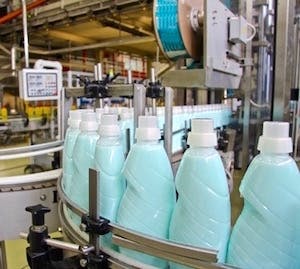
Piston fillers use a highly accurrate, volumetric fill principle, as well, pumping the product from one part of the machine to another. These fillers can be used with a variety of products, but are particularly ideal for thick or high viscousity liquids. Piston fillers can be divided into two different types:
Check-valve piston fillers work well with low viscosity products due to the incredibly auccuracte and efficient transfer process they use, drawing low-viscous liquids from large containers and moving them into bottles with ease.
Rotary-valve piston fillers are ideal for transferring even the thickest types of liquids into containers thanks to a valve which these types of piston fillers are able to use. This allows high-viscousity products to pass through the rotary-valve piston filler quickly and easily without any damage or alteration to the product.
Pump fillers are also designed to accomodate a wide range of liquids and viscousities - although this type of filler works best with thicker, higher-viscous products. These types of filling machines use a volumetric fill principle as well, successfully transferring liquids that may need an extra push through the product pathway in order to get through to the waiting container and ultimately, into each container. Possibly the most versatile of all the various types of volumetric filling machines, pump fillers are able to be designed for whatever particular liquid they might be using to fill the bottles.
7. Should Your Filling Machine Be Capable of Inline or Rotary Filling?
Inline filling machines are cost effective, easily adjustible fillers that fill bottles in the exact way their name suggests - in a line! These machines can be customized to have anywhere between 4 and 20 heads, and are generallly less costly than the rotary fillers. Inline fillers can also be adjusted to fill a variety of different container sizes without any additional costs for the change of parts and are frequently used/favored by small-to-medium-sized companies because of their ability to be stopped during production if any issues arrise or something goes wrong with the machine.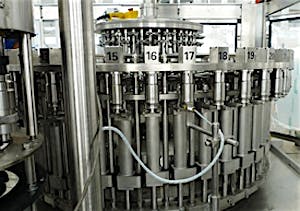
Rotary filling machines are much larger, more specialized fillers that can have 25, 50, or even up to 100+ heads, depending on what level of production need they're filling. These machines are able to produce far more BPM than your average inline filler. However, if a problem occurs mid-production, many bottles are often wasted due to the higher amount of containers required to be in the rotary filler at any given time. Additionally, unlike inline bottle fillers, rotary filling machines cannot be stopped mid-production, making them quite difficult to fix if anything goes wrong with the machine during the filling process. While rotary fillers can initially seem a bit complicated (and definitely more costly!), if you're a large, thriving business with high production requirements, the impressive speed and production volume achieved by this type of filling machine is absolutely unmatched.

